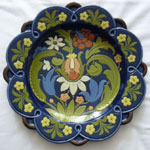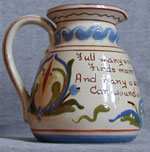Aller Vale Art Pottery on:
[Wikipedia]
[Google]
[Amazon]
The Aller Vale Pottery was formed in 1865 on the northern edge of the village of
 In autumn 1889 the 27-year-old Domenico Marcucci came to Aller Vale as one of the chief designers. He was an Italian decorator from Faenza, a city noted for its
In autumn 1889 the 27-year-old Domenico Marcucci came to Aller Vale as one of the chief designers. He was an Italian decorator from Faenza, a city noted for its
 Phillips' death in 1897 led to a decline at the pottery. Many of the potters left shortly afterwards, including Collard who worked briefly for Hart and Moist Pottery in Exeter, then at Longpark Pottery in Torquay, and then founded the Crown Dorset Art Pottery in Poole, Dorset in 1905. He later bought the
Phillips' death in 1897 led to a decline at the pottery. Many of the potters left shortly afterwards, including Collard who worked briefly for Hart and Moist Pottery in Exeter, then at Longpark Pottery in Torquay, and then founded the Crown Dorset Art Pottery in Poole, Dorset in 1905. He later bought the
Kingskerswell
Kingskerswell (formerly Kings Carswell, or Kings Kerswell) is a village and civil parish within Teignbridge local government district in the south of Devon, England. The village grew up where an ancient track took the narrowest point across a m ...
in South Devon
Devon ( , historically known as Devonshire , ) is a ceremonial and non-metropolitan county in South West England. The most populous settlement in Devon is the city of Plymouth, followed by Devon's county town, the city of Exeter. Devo ...
, England on the likely site of a medieval pottery. It became well known for the creation of art pottery
Art pottery is a term for pottery with artistic aspirations, made in relatively small quantities, mostly between about 1870 and 1930. Typically, sets of the usual tableware items are excluded from the term; instead the objects produced are mostly ...
at the end of the 19th century and gained Royal patronage, but declined thereafter, closing on this site in about 1924. The name continued in use until 1962 related to the production of mass-produced motto ware for the tourist market.
History
There had probably been apottery
Pottery is the process and the products of forming vessels and other objects with clay and other ceramic materials, which are fired at high temperatures to give them a hard and durable form. Major types include earthenware, stoneware and ...
on the site in medieval times, as evidenced by the excavation of medieval tiles there. The pottery was founded in 1865 in the hamlet of Aller between the village of Kingskerswell
Kingskerswell (formerly Kings Carswell, or Kings Kerswell) is a village and civil parish within Teignbridge local government district in the south of Devon, England. The village grew up where an ancient track took the narrowest point across a m ...
and the town of Newton Abbot
Newton Abbot is a market town and civil parish on the River Teign in the Teignbridge District of Devon, England. Its 2011 population of 24,029 was estimated to reach 26,655 in 2019. It grew rapidly in the Victorian era as the home of the So ...
and had originally produced simple kitchenware. In 1868 it was taken over by John Phillips (born 1835 in Shaugh Prior
Shaugh Prior is a village and civil parish on the south-western side of Dartmoor in the county of Devon, England. It is situated about 8 miles north-east of the historic centre of the city of Plymouth. In 2001 its population was 751. The parish ...
), a clay merchant who lived in Newton Abbot. Phillips changed the focus of the company to make builders' earthenware—drainpipes, roof tiles, chimney pots and the like. The company was listed in an 1870 directory as "Phillips, John & Co., manufacturers of architectural pottery and firebricks".
Phillips was influenced by the Arts and Crafts Movement and the ideals of William Morris
William Morris (24 March 1834 – 3 October 1896) was a British textile designer, poet, artist, novelist, architectural conservationist, printer, translator and socialist activist associated with the British Arts and Crafts Movement. He ...
, leading him to set up cottage classes in Kingskerswell and the nearby villages of Abbotskerswell and Coffinswell
Coffinswell is a small village in South Devon, England, just off the A380, the busy Newton Abbot to Torquay road. It lies within Teignbridge District Council.
Coffinswell has a church dedicated to Saint Bartholomew with a Norman font. Near th ...
to teach useful skills to the uneducated young. Up to 64 young people between the ages of 11 and 23 attended these twice-weekly classes where they learned pottery, wood and stone carving, painting, stitching, embroidery, and ironwork which was taught by the local blacksmith.
Art pottery
Under Phillips's control the works started producingart pottery
Art pottery is a term for pottery with artistic aspirations, made in relatively small quantities, mostly between about 1870 and 1930. Typically, sets of the usual tableware items are excluded from the term; instead the objects produced are mostly ...
in 1881 after it was rebuilt following a fire. At this time it was renamed as the Aller Vale Art Pottery. In 1886 the pottery was visited by Princess Louise, daughter of Queen Victoria, after she had bought some of its wares. This was the start of a long period of patronage and led to the pottery being renamed as the Royal Aller Vale Pottery. Other members of the Royal family also became customers, including Princess Alexandra. Between 1887 and 1901 Aller Vale Art Pottery was stocked by Liberty & Co
Liberty, commonly known as Liberty's, is a luxury department store in London, England. It is located on Great Marlborough Street in the West End of London. The building spans from Carnaby Street on the East to Kingly Street on the West, where ...
in London.
 In autumn 1889 the 27-year-old Domenico Marcucci came to Aller Vale as one of the chief designers. He was an Italian decorator from Faenza, a city noted for its
In autumn 1889 the 27-year-old Domenico Marcucci came to Aller Vale as one of the chief designers. He was an Italian decorator from Faenza, a city noted for its faience
Faience or faïence (; ) is the general English language term for fine tin-glazed pottery. The invention of a white pottery glaze suitable for painted decoration, by the addition of an oxide of tin to the slip of a lead glaze, was a major a ...
pottery. Marcucci had been involved in two exhibitions in London during the previous year: an Italian exhibition in Kensington, and one of ceramics at William De Morgan
William Frend De Morgan (16 November 1839 – 15 January 1917) was an English potter, tile designer and novelist. A lifelong friend of William Morris, he designed tiles, stained glass and furniture for Morris & Co. from 1863 to 1872. His tiles ...
's premises. His influence had a great impact on the designs and the quality of Aller Vale's pottery. Marcucci is thought to be responsible for the introduction of a design of blue slipware
Slipware is pottery identified by its primary decorating process where slip is placed onto the leather-hard (semi-hardened) clay body surface before firing by dipping, painting or splashing. Slip is an aqueous suspension of a clay body, whi ...
scrolls over a cream ground which was admired by Princess Alexandra, who placed a special order for it. She asked that the design should be called Sandringham Ware and it was marketed under that name.
Charles Collard worked as an apprentice to Phillips from the age of 12 in 1886 and, under Marcucci's influence, rose to be one of the top decorators at the pottery by the mid-1890s. His designs were also strongly influenced by İznik pottery
Iznik pottery, or Iznik ware, named after the town of İznik in western Anatolia where it was made, is a decorated ceramic that was produced from the last quarter of the 15th century until the end of the 17th century.
İznik was an established ...
.
Decline
 Phillips' death in 1897 led to a decline at the pottery. Many of the potters left shortly afterwards, including Collard who worked briefly for Hart and Moist Pottery in Exeter, then at Longpark Pottery in Torquay, and then founded the Crown Dorset Art Pottery in Poole, Dorset in 1905. He later bought the
Phillips' death in 1897 led to a decline at the pottery. Many of the potters left shortly afterwards, including Collard who worked briefly for Hart and Moist Pottery in Exeter, then at Longpark Pottery in Torquay, and then founded the Crown Dorset Art Pottery in Poole, Dorset in 1905. He later bought the Honiton Pottery
Honiton pottery is a type of earthenware pottery from Honiton, Devon, England. The popular design was Jacobean, and the most famous designer was Charles Collard who learned his trade at the Aller Vale Pottery in Kingskerswell
Kingskerswell ...
which continued in production until the 1990s.
On Phillips's death, Aller Vale was acquired by Hexter, Humpherson & Co., a Kingsteignton
Kingsteignton ( ), is a town and civil parish in South Devon, England. It lies at the head of the Teign Estuary to the west of Teignmouth in the Teignbridge district. It is bypassed by the A380 and is also on the A383, A381, B3193 and B3195 ...
-based company that manufactured tiles and sanitary fittings. In 1901 they also acquired the Watcombe Pottery in Torquay
Torquay ( ) is a seaside town in Devon, England, part of the unitary authority area of Torbay. It lies south of the county town of Exeter and east-north-east of Plymouth, on the north of Tor Bay, adjoining the neighbouring town of Paig ...
and amalgamated the two companies as the "Royal Aller Vale & Watcombe Pottery Company". This company, with its name sometimes simplified to "Royal Watcombe" continued working until 1962, mostly creating motto ware for the tourist market.
Work at the Aller Vale Pottery site ceased in about 1924, and the site is now occupied by a small estate of offices and light business units, surrounded by houses.
References
Sources
* *{{cite book , editor= Keith Poole , title=The Art of the Torquay and South Devon Potters , publisher=The Torquay Pottery Collectors' Society , year=1996 , location=Torquay , isbn=0-9515089-4-6 Devonian pottery Art pottery Ceramics manufacturers of England History of Devon